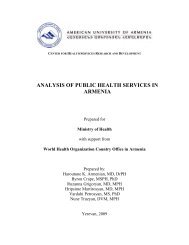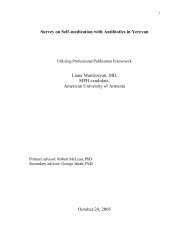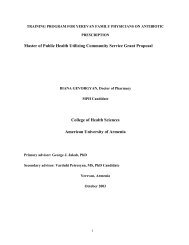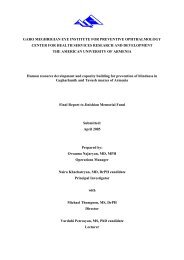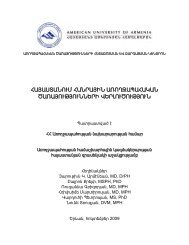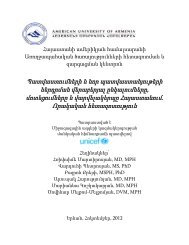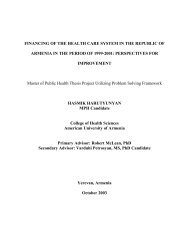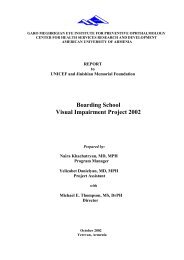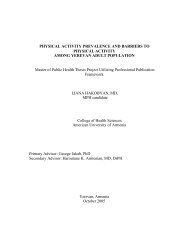A M E R I C A N U N I V E R S I T Y O F A R M E N I A - CHSR
A M E R I C A N U N I V E R S I T Y O F A R M E N I A - CHSR
A M E R I C A N U N I V E R S I T Y O F A R M E N I A - CHSR
Create successful ePaper yourself
Turn your PDF publications into a flip-book with our unique Google optimized e-Paper software.
using the formula: N=z 2 [P1(1-P1) + P2(1-P2)] /d 2 , where z= 1.96 (level of significance<br />
α=0.05), P1= 0.55, (55% of children from low SES will have at least one health problem),<br />
P2=0.4 (40% of children from high SES will have at least one health problem), and d=0.15<br />
(15%), the assumed practical difference between frequency of health problems in children with<br />
low SES, and high and middle SES [22]. Thus, each group should contain at least 84 children,<br />
and two groups should equal to 168.<br />
According to the survey purpose, about 497 children were examined in the study. Evaluating<br />
the data, 76 children have been excluded. The reason was that initially the research question of<br />
the evaluation program was addressed to children in age 24-108. Therefore, the exclusion<br />
criterion was age factor, and the analytic sample, drawn from cross-sectional study, has been<br />
restricted to 421. The theoretical calculation of the sample size with the proportion 1: 2 of<br />
unexposed (high SES) to exposed (low SES), using EpiInfo2000, also justified that the analytical<br />
sample size is entirely met the minimal sample size requirements.<br />
Definition of the variables<br />
In general, the health status, defined by the WHO is a “state of complete physical, mental and<br />
social well-being and not merely the absence of disease and infirmity” [26]. There are different<br />
health status measures, which are during recent 15 years were sufficiently well developed and<br />
tested [27]. These types of measures can be classified into two groups: a group for assessment of<br />
general health using the questionnaire and other instruments for assessing physical and mental<br />
health like Activities of Daily Living (ADL) or SF-36; and a second group that includes the<br />
measures for assessing the absence or severity of diseases and disorders [26]. First group<br />
measures are not applicable for children; therefore, early detection system including screening,<br />
developmental assessment, identifying the risk factors and protective factors for health and well-<br />
16




